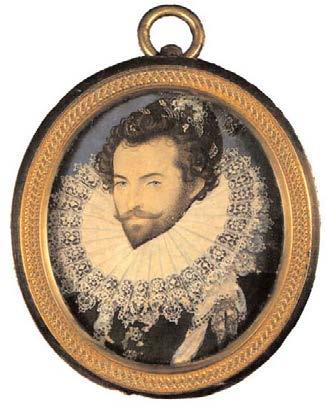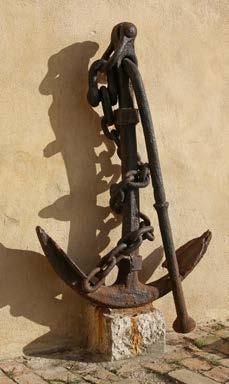
7 minute read
SIR WALTER RALEIGH
He lost his head. Bess kept hers (and his).
As many a contemporary high-profile public figure has found, Raleigh’s concealment of damaging secrets merely lead to greater trouble in the end.
Advertisement
Raleigh was born to the quietly formidable Elizabeth Champernowne, the third wife of Raleigh’s father. She was the widow of Otho Gilbert, with whom she had produced three sons, Adrian, Sir Humphrey and Sir John Gilbert. All three, along with the two sons from her marriage to Raleigh Senior, Sir Carew and Sir Walter, emerged as able, ambitious and intellectually powerful personalities. In Raleigh, there was also a questioning mind, fertile imagination and an originality of thought that was to play such a part in his securing the Queen’s admiration, but which may well have also laid the foundation for his apparent atheism, one of the two fatal secrets.
Once brought to the attention of Queen Elizabeth, Raleigh’s good fortune came swiftly. There seems little doubt that his physical attractiveness and compelling spirit played a large part in the process. His enjoyment of the Queen’s patronage was similar to that of Robert, Earl of Essex, his great rival and detractor. By too closely linking their fortunes to the capricious Monarch both were to come to grief.
Adventurer, Writer, Poet, Spy, Patron of the Arts (he mentored Edmund Spenser, author of The Faerie Queene), Knight of the Realm, Captain of the Guard and commander of three major expeditions in the service of the Queen, Raleigh was a man of complex personality and robust temperament. He was twice imprisoned for fighting and twice challenged to duels. His success generated resentment and unpopularity and he was perceived by the De Veres and the Devereaux of the age as Raleigh:anoilpainting a ‘jack’ a ‘knave’ and an ‘upstart’. This is ironic, as one of the reasons for the Queen’s extreme displeasure on hearing of his secret marriage to Elizabeth Throckmorton (Bess), was her belief that he had married beneath him. The scandal of his liaison with one of the Queen’s ladies-in-waiting was the second fatal secret.
Elizabeth first rewarded him with large estates for his exploits in Ireland. Throughout the early 1580s his favour grew: he was given trade privileges and the right to colonise America; received the patent for granting licenses to sell wine; knighted; awarded a London residence in Durham House and became captain of the Queen’s guard. He reached his probable zenith in January 1592, with the bestowing of the country seat of Sherborne Castle. As an aside, Raleigh never ‘owned’ Sherborne. Queen Elizabeth had identified Dr John Coldwell as a candidate for the Bishopric of Salisbury, and he was persuaded, possibly as an inducement to gain the appointment, to release to the Crown the Estate of Sherborne and its manors on a 99 year lease. Subsequently, this was sub-let to Raleigh for £200 pa (about £55,000 today). 34
It is possible Raleigh’s role was not just that of unwitting grateful subject. As one 19th century historian writes:
“He (Raleigh) seems to have effected his design not without some fraudulent or perhaps violent means…..and (this) was probably the cause of his misfortunes… raisingthe envy and avarice of his fellow courtiers, who waited for, and soon after found, an opportunity to deprive him of it”.
It was at this point his attempts to guard the secrecy of his liaison with Bess Throckmorton misfired. Was jealousy one reason why the Monarch reacted so angrily and vengefully on hearing of Raleigh’s affair? There is no doubt the relationship between Queen and subject was erotically charged, as much of his verse about the Queen (or Cynthia as she was known in his poems) suggests: Those eyes that set my fancy on a fire Those crisped hairs that hold my heart in chains Those dainty hands which conquered my desire That wit which of my thought doth hold the reins.. Leaving aside the question of whether ‘crisped hairs’ are that romantic a concept, such sentiments are not those of a distanced, formal relationship. Historians consider a physical relationship to have been unlikely, but if one had occurred, neither the Queen or Raleigh are likely to have left a detailed account. If Raleigh ever believed the Queen’s favour might turn into something grander, by the 1590s reality must have dawned. He was by then in his late 30s. Bess Throckmorton was 25. Their secret romance was underway. In his poetry, Bess is ‘Serena”:Bess:byallaccounts,notanoilpainting Now, Serena be not coy; Since we freely may enjoy; Sweet embraces, such delights; As will shorten tedious nights….
Raleigh was about to command an expedition designated to attack a Spanish Treasure Fleet off Panama. Part-financed by the Queen, though more substantially by Raleigh, the fleet’s sailing was delayed by bad weather. The Queen began to have second thoughts about the mission. This was disturbing for Raleigh, as the potential loss of the Queen’s contribution or outright cancellation would be ruinous. Worse, Raleigh’s role in the adventure was to change, the Queen had arranged for Martin Frobisher to assume the command. Surely Raleigh knew his secret was out? He ends a letter written from Chatham, Kent to Robert Cecil on March 10 1592:
“I mean not to come away, as they say I will, for fear of a marriage (ie his marriage).
If any such thing were (true) I would have imparted it to you before any man living… I beseech you to suppress what you can any such malicious report…” This was a blatant lie, as Raleigh had married Bess the previous November. Moreover, she was in advanced pregnancy. On March 29 Arthur Throckmorton wrote:
Although Bess attempted to return to court, her duplicity was seen as gross effrontery to the Queen and from August to December she was confined to the Tower. Raleigh was at first placed into the custody of Cecil. Conceivably this unexpectedly modest punishment was to give Raleigh and his wife time to show contrition. If so, the opportunity was missed. Nevertheless, Raleigh, being useful, was more quickly freed, on September 15, in order to organise distribution of the treasures of the Spanish carrack Madre de Dios, which had been captured by his ships off the Azores.
Raleigh had regained his freedom, but his position was fatally weakened, especially after the Queen’s death, to the encouragement of his many detractors and enemies. None was more formidable than Elizabeth’s successor James I (“the wisest fool in Christendom”). Robert Cecil, once helpful to Raleigh, now intrigued against him. He had plenty of ammunition. There was the continued suspicion of Raleigh’s atheism, considered Elizabeth1st:‘crispedhairs’? at the time synonymous with with treason. He was known to be involved with The School of Night, a group of poets and scientists - including Christopher Marlowe - all thought to have atheist leanings. Sir Francis Bacon's essay "Of Atheism” was widely circulated, but it was wise not to admit you had read it. A Reverend Ironside recordeda “dangerous conversation” at a supper given by the Deputy Lieutenant of Dorset which incriminated Raleigh and his brother Carew (a report was later passed to the Privy Council as evidence).
Cecil induced Lord Henry Howard “the subtle serpent” and a resolute enemy of Raleigh for 20 years, to weave with him a disparate and murky case against Raleigh unconvincingly connected to the ‘Bye Plot’ or ‘The treason of the Priests’. This case would be described today as ‘trumped up’. Conviction was a formality, as was the sentence: hanging, drawing and quartering. James played a cruel game, arranging for the execution of three other alleged plotters to be enacted prior to Raleigh’s, in his full view from the Bloody Tower, commuting them only as they stood on the scaffold. Raleigh must have experienced emotional turmoil as the three men were led away with their heads very much on. After an agonising delay, he too was spared. His imprisonment continued for 13 years, but he was allowed to live in the Tower with his servants and the loyal Bess. He wrote his ‘History of the World’ (1614) and even produced a second son, Carew.
He was released in 1616 and immediately seized upon the idea of an expedition in search of gold in South America. Unfortunately, he invaded and pillaged Spanish territory at a time James was seeking peace with Spain, and was forced to return to England, where the charge of treason was at once resurrected. This time, there was to be no commutation. He was executed on October 29 1618, at Old Palace Yard, Westminster. He was buried immediately at nearby St Margaret’s Church, though it was reported that Bess carried away his head in a red velvet bag. It was preserved and remained with the family until finally buried along with Carew, in 1667.










